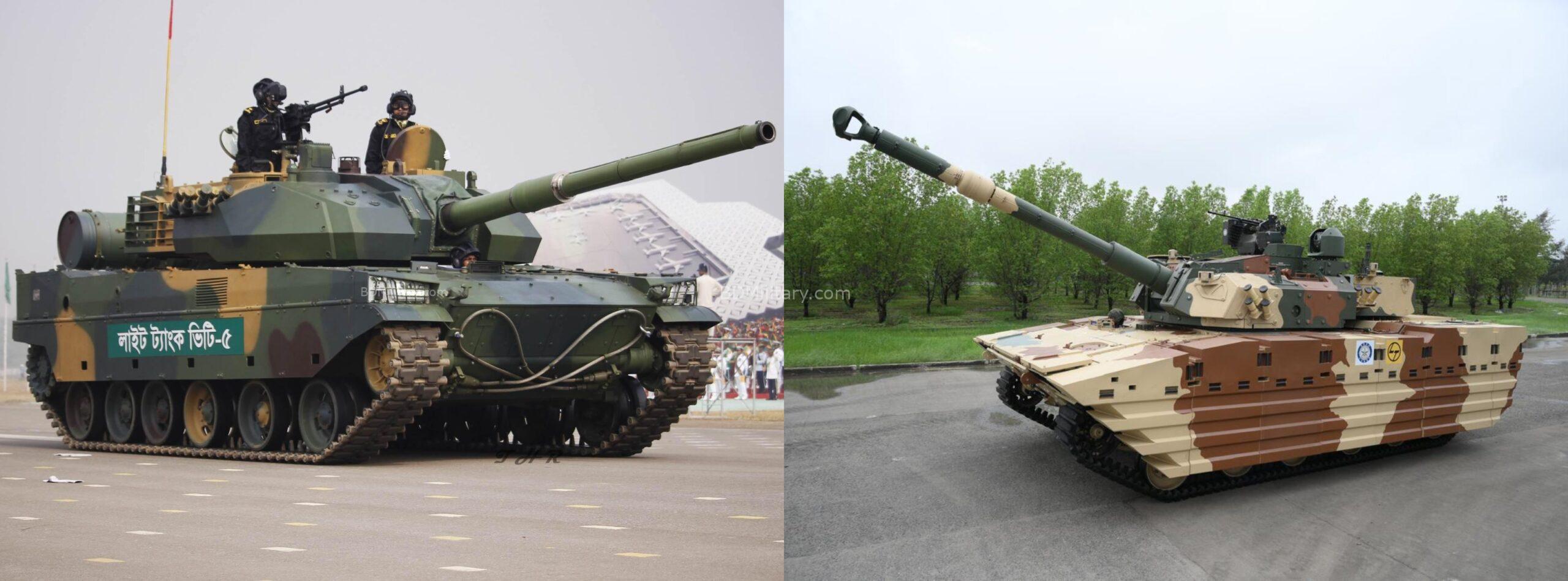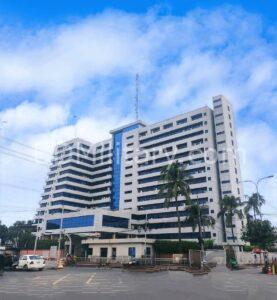In the Bengal delta and North-East India–Bangladesh theatre, armoured warfare is shaped less by open plains and more by waterways, causeways and alluvial terrain. Light tanks were once thought to hold the advantage in such conditions — until the Bangladesh Army’s riverine engineering capability changed the equation entirely.
With up to 70 MLC-class bridging systems and dedicated riverine engineer formations equipped with landing craft and ferries, Bangladesh can now project and sustain its VT-5 light tanks across complex terrain at operational tempo. This development has profound implications for the balance between Bangladesh’s Chinese-made VT-5 and the Indian Army’s indigenously developed Zorawar light tank.
Operational Overview
The Bangladesh Army’s mechanised forces have evolved from route-bound formations into highly mobile riverine-capable elements. Their doctrine now fuses traditional armoured manoeuvre with amphibious and bridging operations, leveraging specialist engineer formations that can create multiple crossing points within hours.
By contrast, the Indian Army’s Zorawar programme, born out of the need for a lightweight, rapidly deployable tank for high-altitude and restrictive terrain, offers a different design philosophy: mobility and deployability over protection. While formidable in the Himalayas and narrow valleys, its advantages diminish when opposing a force that can move heavier tanks seamlessly across rivers and wetlands.
Engineering Advantage: Bridging the Mobility Gap
The decisive factor in this theatre is mobility through obstacle-crossing. Traditionally, Bangladesh’s soft-soil environment would have constrained heavy vehicles to fixed causeways, giving a lighter tank like Zorawar a natural edge. However, the Bangladesh Army’s 70 MLC-capable bridging systems and riverine formations equipped with landing craft and ferries fundamentally alter this assumption.
- Freedom of Manoeuvre: VT-5 formations can now conduct multi-point crossings across distributaries and polders, launching from concealed sites with engineer support.
- Operational Tempo: Bridging and landing craft reduce dependency on fixed infrastructure, ensuring rapid resupply and reinforcement.
- Unpredictability: With numerous potential crossing sites, the enemy cannot anticipate the main thrust, complicating Zorawar ambush planning and ISR coverage.
In essence, the Bangladesh Army has transformed its riverine geography from a liability into a tactical weapon system.
Sensors, Environmental Vulnerabilities and Anti-Tank Threats
Modern electro-optical and thermal sensors give light tanks a decisive edge in detection and engagement, but they are not invulnerable. Environmental factors common to the Bengal delta — dense morning fog, monsoon rain, river mist, humidity and salinity — degrade infrared signatures, obscure laser returns and distort thermal contrast. Thermal crossover at dawn and dusk further reduces the detection window for both commander and gunner sights, while smoke, dust and aerosol countermeasures can mask manoeuvre and disrupt hunter-killer cycles.
These vulnerabilities are magnified by Bangladesh’s anti-tank ecosystem, which blends snipers, UAVs and guided weapons. The Bangladesh Army fields specialised sniper and tank-hunting parties equipped with HJ-12 ATGMs, Alcotan-100 launchers and UAV-guided TRG-230 GMLRS-class munitions. These assets can ambush from concealed positions, direct fires onto turret roofs or rear arcs, and engage tanks beyond the effective range of their optical sensors. Combined with environmental degradation of sensor performance, they represent a serious threat to both VT-5 and Zorawar crews.
For both armies, survival depends on combined arms integration. Tanks must be protected by short-range air defence, counter-sniper units and obscurant-generating smoke systems. Engineers and bridging trains — the lifeblood of riverine mobility — are particularly vulnerable and require layered air and ground protection to maintain the offensive tempo.
Combat Comparison: VT-5 vs Zorawar
| Category | Bangladesh Army VT-5 | Indian Army Zorawar |
|---|---|---|
| Role | Light tank for manoeuvre and shock action | Air-transportable light tank for high mobility |
| Weight | 33–36 tonnes | ~25 tonnes |
| Main Gun | 105 mm rifled gun, ATGM capable | 105 mm rifled gun (Cockerill turret) |
| Crew | 3 (commander, gunner, driver) | 3 (commander, gunner, driver) |
| Engine Power | ~1,000 hp | ~760 hp |
| Power-to-Weight Ratio | ~27–30 hp/t | ~30 hp/t |
| Protection | Composite with modular ERA, optional APS | Modular composite, ERA provisioned |
| Top Speed (Road) | ~70 km/h | ~70 km/h |
| Operational Range | 450–470 km | 400–450 km |
| Manufacturer | NORINCO, China | DRDO/L&T, India |
Scenario-Based Assessment
Scenario 1 – Multi-Point River Crossing and Exploitation
Outcome: Advantage – Bangladesh (VT-5)
With rapid bridging and landing craft support, VT-5s can establish and expand multiple bridgeheads faster than Zorawar units can interdict. The heavier tank’s superior protection and stabilised firepower dominate once ashore.
Scenario 2 – Close Terrain Ambush (without engineer support)
Outcome: Advantage – India (Zorawar)
In narrow village lanes or marginal tracks where engineers are absent, Zorawar’s lighter footprint and high mobility confer the edge — but only in limited, localised engagements.
Scenario 3 – Sustained Riverine Offensive
Outcome: Advantage – Bangladesh (VT-5)
With bridging, ferries and dedicated engineer logistics, Bangladesh maintains operational tempo and resupply, ensuring VT-5s can fight continuously across shifting fronts.
Scenario 4 – Precision Interdiction of Bridging Assets
Outcome: Contested
If India successfully employs UAVs, artillery or special forces to destroy Bangladesh’s bridging trains or landing craft, the mobility advantage could be temporarily blunted.
Doctrinal Implications
- For Bangladesh:
The fusion of riverine and mechanised doctrine creates an asymmetric advantage in a geography most armies find restrictive. Future improvements should focus on air defence for bridging assets, field-level electronic warfare, and enhanced counter-UAV capabilities to protect riverine crossings. - For India:
The Zorawar must evolve from a mountain-optimised tank into a system integrated within a broader combined-arms architecture. To counter Bangladesh’s mobility, India will need persistent ISR coverage, precision strike capabilities against engineer support elements, and dedicated anti-bridge weaponry.
Strategic Balance
Bangladesh’s advantage lies not merely in possessing a capable light tank, but in developing the infrastructure and doctrine to move it anywhere, anytime.
Zorawar represents a promising domestic design, but within this theatre, its edge is limited to isolated ambush zones or interdiction roles.
Ultimately, the side that can sustain continuous riverine mobility, engineer survivability and resilient sensor performance — not merely mobility on dry ground — will dominate in this unique environment.
Annex: Technical Specifications
VT-5 Light Tank (Bangladesh Army)
- Origin: NORINCO, China
- Combat Weight: 33–36 tonnes (depending on configuration)
- Crew: 3
- Main Armament: 105 mm rifled gun with autoloader, capable of firing APFSDS, HEAT and gun-launched ATGMs
- Secondary Armament: 7.62 mm coaxial MG, 12.7 mm RWS (optional)
- Engine: 1,000 hp diesel
- Power-to-Weight Ratio: ~28 hp/t
- Max Speed: 70 km/h (road)
- Range: 450–470 km
- Protection: Modular composite armour, ERA blocks, laser warning system, and optional APS
- Fire Control System: Digital ballistic computer, thermal sights, and stabilised hunter-killer optics
- Operational Role: Rapid-response light tank capable of amphibious and mountain operations
Zorawar Light Tank (Indian Army)
- Origin: DRDO / Larsen & Toubro, India
- Combat Weight: ~25 tonnes
- Crew: 3
- Main Armament: 105 mm rifled gun (John Cockerill turret), ATGM-capable
- Secondary Armament: 7.62 mm coaxial MG, optional 12.7 mm RCWS
- Engine: Cummins VTA903E-T760 (≈760 hp)
- Power-to-Weight Ratio: ~30 hp/t
- Max Speed: 70 km/h (road)
- Range: 400–450 km
- Protection: Modular composite armour, ERA provisioned, APS-ready design
- Fire Control System: Advanced digital FCS with panoramic commander’s sight
- Operational Role: Lightweight, high-mobility tank for rapid deployment in restricted or high-altitude terrain
Final Assessment
With the VT-5’s combination of heavier armour, advanced fire control and the Bangladesh Army’s unmatched riverine engineering capacity, Dhaka’s armoured forces possess a decisive operational edge in the delta theatre.
India’s Zorawar remains a capable platform, particularly for mountain warfare and mobile reconnaissance, but within the Bengal plains, the tactical environment increasingly favours Bangladesh’s integration of engineering, sensor warfare and layered anti-tank doctrine.
In future conflicts, bridges, sensors and snipers may decide battles as much as guns and armour.

Amit Bhattacharya is a leading defence procurement expert with deep expertise in modern weapon systems and military hardware acquisition. Over more than a decade, he has collaborated with top defence contractors and strategic research institutions, delivering incisive analysis on procurement frameworks, capability development, and technology integration for armed forces worldwide. Amit bridges the gap between operational requirements and industrial capacity, providing authoritative evaluations of modernisation programmes, defence budgets, and acquisition reforms in both established and emerging defence markets. He leads the Defence Procurement and Defence Industry sections at BDMilitary, shaping strategic discourse on defence innovation. Amit earned his Master of Policy and Governance (MPAG) from the University of Canterbury, New Zealand, complementing his practical expertise with advanced policy and governance insight.


